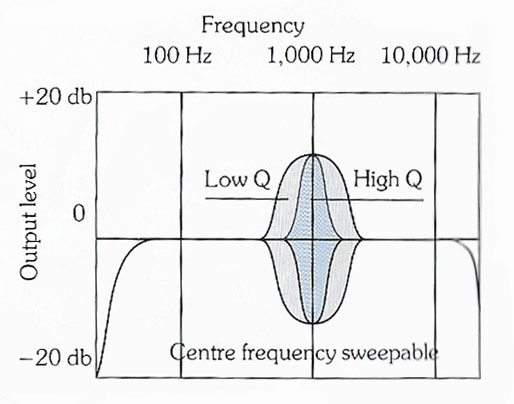equalization

Figure 1 . Effect of a parametric equalizer. The area shaded gray shows the effect range of the mid-lift and cut of the parametric at low Q (wide bandwidth setting). Increasingly, Q narrows the bandwidth. The area shaded blue shows a typical maximum Q setting.
Equalization, known as EQ for short, is the process of using electronic devices or digital algorithms to modify frequency response to alter tonal balance or remove undesired frequencies.
Thus an equalizer is a device or digital algorithm that changes the frequency response of a signal passed through it. It consists of a group of tone controls that allow adjustment to the full frequency range of an incoming signal in a number of separate bands. A simple equalizer would consist of controls for bass, middle, and treble ranges, usually with a central 0 dB setting. Turning a knob clockwise boosts the frequency, turning it clockwise cuts the freqiency.
Sweep equalizers
Although some amplifier designs incoporate as many as three mid-range tone controls, a more elaborate method frequently used on a mixing desks and available alsoa foot pedal is to have one or two sweep frequency controls. A sweep equalizer has the usual lift/cut control, but also an additional control which allows you to shift the center frequency of the control up or down the audio spectrum to a higer or lower frequency. This more flexible arrangement allows more accurate adjustmant. The turnover frequency of treble and bass controls is also often sweepable on mixing desks.
On amplifiers fitted with two sweep frequency conrols and two lift/cut controls, dramatic effects can be achieved if the area of operation of the controls is overlapped. A wah-wah pedal is simply a sweep equalizer with a fixed amount of lift.
Parametric equalizers
Parametrc equalizers (as swepp equalizers are sometimes incorrectly called) have an additional control – the "bandwidth" or "Q" control. "Q" refers to the steepness of the slope on each side of the center frequency (Figure 1). On cheap parametric equalizers you simply switch from "low Q" to "high Q", but the best have a totally variable "Q" control (which allows you to select a suitable bandwidth) and also a frequency control as on a sweep equalizer, permitting precise shaping of the sound.
One way in which a parametric equalizer can be used on stage as well as in the studio is to remove a small peak of accentuated frequencies. In the studio, the peak might merely affect one note, or a group of notes, by making them louder, but on stage it may cause them to feed back. In both cases, a single note would require a high Q, whereas a group of notes is more likely to need the wider frequency bandwidth cut of a low Q.
Graphic equalizers
Originally designed for studio use, graphic equalizers can now be found on guitar amplifiers, foot pedals and domestic stereo systems. Technically more complex than parametric equalizers, they are paradoxically much easier to operate and can, if they offer sufficient facilities, do the job of all other kinds of equalizer. The graphic equalizer uses sliding controls called "faders" arranged with their tracks parallel to one another. Each fader controls a particular band of frequencies and is labelled with the centre frequency of that band. This may cover a full octave, a half, or a third, or even a sixth of an octave. Obviously, the more faders the equalizer has, the greater its versatility, although this creates design problems in trying to keep noise and harmonic distortion down to acceptable levels. If you look at the fader knobs on a graphic equalizer as though they were points on a graph. and think of the curving line that would link them all together most smoothly, then this would recreate exactly the type of graph used to illustrate the effects of an equalizer. This is the feature that makes a graphic equalizer so easy to use, and also explains its name.
Filters
Filters can be designed to remove or to pass any desired frequency or band of frequencies, although high-pass and low-pass filters are the types most frequently encountered. High-pass filters resemble bass-.cut controls: all frequencies above their turnover frequency remain unchanged, while frequencies below the turnover point are sharply reduced. The chief difference is that the slope of the filter is generally invariable and much steeper than that of the bass control. A similar comparison can be made between the standard treble control and a low-pass filter.


